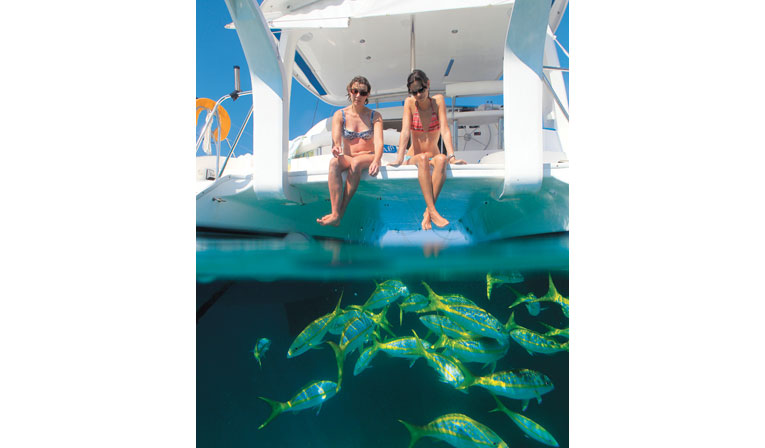Photo courtesy of The Moorings
Enjoy the breathtaking, laid-back atmosphere of this Central American paradise.
I floated face down in water as clear as gin and, ahem, I should know. The white sandy bottom was a couple of dozen feet away, but I felt as if I could reach out and touch the sugary powder. I had the eerie feeling that there really was no water: I was supported by invisible threads in mid-air.
The only sound was my breathing through the snorkel and, I admit it, my mind drifted wickedly. I thought of the phone calls I’d had in recent days before catching a flight to Belize for a week of bareboat chartering.
I’d talked to a good friend in Chicago, who told me the slush on the streets was eight-inches deep, that another storm was due that night, and he was worried about keeping his driveway clear. I talked to a friend in the Northeast, who said it had gotten as high as 11-degrees that afternoon. And I talked to friends in Seattle who hadn’t seen the sun in two months.
Here’s a tip: Don’t laugh with a snorkel in your mouth.
Yes, things were far better in Belize. The air temperature was in the high 70s, the water temperature was in the mid-70s and, frankly, it was hard to tell where one started and the other stopped. Fluffy white clouds drifted past overhead, and the sunsets were spectacular. I think Belize is the way they spell “paradise” in the Western Caribbean.
Let’s cut to the chase: Why would you charter a bareboat in Belize? Well, for one thing, because it’s what the Caribbean used to be fifty years ago. Although it shows some stirrings (a superyacht marina is being built in Placencia), it remains as untouched and laid back as when it was a Crown colony known as British Honduras.
Most important, however, is that Belize is absolutely gorgeous. You’ll be the first person to put footsteps on most of the beaches, the water is perfect, and the snorkeling is out of this world. Trade winds blow steadily most of the time, so you not only have good sailing but you have natural cooling at anchor. And, speaking of anchoring, you don’t have to race from harbor to harbor just to get a good spot. You may find yourself surprised to see another boat.
Now, for your geography lesson. Most people don’t place Belize within a thousand miles of where it really is, which is on Caribbean side of Central America, tucked under the bulge of Mexico’s Cancun Peninsula and with its southern and western sides pressed against Guatemala. Flying time is just two hours from Miami, and Belize City is served by nonstops from a number of North American hubs.

Photo courtesy of The Moorings
Belize Charter Tips
Getting there: Gateway cities to Belize are Miami, Houston and Dallas via American, Continental and TACA airlines. Once in Belize, Tropic Air is your commuter airline to the charter base, and it’s a good idea to book this flight through your charter company.
Currency: Two Belize dollars are worth about one U.S. dollar. U.S. dollars are generally accepted, with change given in Belizean dollars. Visa (best) and Mastercard (next best) are accepted at hotels and restaurants on the mainland, but supermarkets and services in the islands require cash. ATMs are non-existent.
Language: English is the official language and widely spoken, along with Spanish.
Immigration: Passports but not visas are required for U.S. and Canadian citizens. You must have either a return or ongoing ticket. A departure tax of about US$40 is charged per person.
Climate: Dry season is January to April; rainy season is July to October.
What to take: Two swimsuits (so one can dry), walking shoes, sandals or reef runners for exploring, hat or cap, polarized sunglasses and plenty of sunscreen.
Provisioning: Once you’re away from the charter base, there isn’t much available, so plan to take all your food and plenty of water with you. Each of the charter bases has grocery stores within taxi distance, or you can have the charter companies provision the yacht for you.
Additional fees: Park fees of US$10 per person per day are charged at marine reserves in the cruising grounds. A departure tax of about US$40 is charged per person. Fishing licenses of US$25 per week are required if you plan to fish, with large fines and prison terms for violations.
Communications: Cell phone service, particularly with Sprint or Verizon, is good, but check with your carrier to make sure you have international roaming. — C.C.
Photo courtesy of The Moorings
But, in a word, the reason you’ll come to bareboat in Belize is the reef. Stretching for more than 350 miles south from the tip of Cancun and protecting the shore of Belize, the Mesoamerican Reef is the second largest barrier reef (behind Australia) in the world.
Scattered behind and around this reef are more than 400 islands and cayes. Many are deserted and look just like your mental picture of a beachcomber’s dream: A few palms, blue-green waters, a perfect sandy islet. In the waters around these islands are more than 500 species of fish, and it is like swimming in an aquarium.
Here’s the disclaimer: If your idea of fun is spending your evenings in a marina and going ashore to dine and dance, stop reading right here. If you want cutesy pastel tourist villages with shops selling faux native crafts, well, you’re out of luck.
What you will find in Belize, however, is serenity. The serenity that comes from having an anchorage all to yourself. Of swimming from a pristine beach and snorkeling above a huge reef of living coral. Of your kids touching a starfish for the first time and giggling helplessly. Or of just sprawling in the cockpit with a trashy novel, a little Diana Krall gentle in the background, and something rummy and cold in the foreground.
There are three major bareboat charter companies in Belize: The Moorings and its sister company, Sunsail, both of which are based in Placencia; and Tortola Marine Management in San Pedro. All offer a range of monohulls and catamarans in sizes to fit your planned crew. For our adventure, we went through The Moorings and reserved a Moorings 4000, a 39-foot catamaran with three staterooms and two heads that was perfect for two couples and some kids.
We chose the catamaran not just because it gave us great privacy with the cabins in each corner of the two hulls, and not just because we liked the spacious deck areas, and not just for the springy trampoline at the bow on which we lay to watch the stars at night. We chose it because, by and large, the Belizean waters inside the reef are fairly shallow. With just a three-foot draft, we wouldn’t have to watch the chart as closely as we would with the six-foot or more draft of a monohull. And, because we could navigate thin water, we were able to get close to the beaches and into quiet anchorages.
Sailing the waters of Belize doesn’t require the skills necessary for a voyage through, say, the swirling waters and rocks of the Scottish Hebrides; but, on the other hand, you need to pay attention. Most of the charter boats have chartplotters and GPS, all have paper charts and cruising guides, but your primary navigation tools are your eyes. Take polarized sunglasses so you can read the changing colors of the water: Deep water is blue; skinny water is increasingly pale or turquoise.
One interesting option for bareboating in Belize: Choose a one-way charter. This costs extra, but it allows you to mosey through the islands without having to double back.
If you’re a qualified scuba diver, you can arrange to rendezvous with one of the many dive shops in Belize that will provide you with tanks and gear, as well as guides to the best diving sites.
I won’t bore you with the minute-by-minute details of our charter, because Belize offers a diversity of possible charter itineraries. Unlike the British Virgin Islands, where most charterers depart Tortola and then make a counter-clockwise circuit of the islands, you can cruise Belize several times and never follow the same path. So here are some tasty destinations for you to consider:
Wippari Cay—Mooring buoys are usually available and, since this is a just 14 nautical miles from Placencia, a good place for your last (or first) night. The Sea Urchin Bar has great seafood, and there is impressive bonefishing nearby.
South Water Cay—About 22 nautical miles from Wippari, this is your introduction to fabulous snorkeling, with a menagerie of brightly colored tropical fish and even the occasional ray. Part of Belize’s World Heritage Site, this 15-acre coral island is dotted with coco palms and mangrove islets. Several mooring buoys are available with good protection from the prevailing easterlies. Ashore, there are some restaurants (freshly caught lobster, yum!), bars and a dive shop. With so much wildlife, it’s no surprise there are two scientific research facilities (one from Smithsonian) on the island.
Cocoa Plum Cay—Several mooring buoys and a dinghy dock with water lead to a resort and restaurant ashore. Nature paths wander around the caye, where you’ll see coatimundi, Belizean raccoons and sea iguanas.
Lagoon Caye—Really two cayes separated by a deepwater channel, there are moorings, a ring of shallow coral for snorkeling and a chance to kayak in the lagoon.
Queen Cays—Three pristine islets with beautiful reefs for snorkeling and moorings off the southern caye offer good shelter. This is where huge whale sharks come after the full moon between April and June and, though harmless, they could be heartstopping if you weren’t expecting them.
Caye Caulker—With a charming village, this caye is a popular international destination in a relaxed and barefoot style. Don’t miss Glenda’s for freshly baked cinnamon rolls.
Tobacco Caye—More good snorkeling and great for dinghy exploration. The perfect desert island of sand and palms.
Laughing Bird Cay—Named for the laughing gulls, there is a coral restoration project here, and you may meet the “coral gardener” responsible for nursing the growing reef.
One bit of advice: Almost every bareboat charter crew returns wishing they’d left a few days to explore Belize after their charter trip. Save a few days at the end, and you’ll be well rewarded.
The Mayan civilization dates back to 2500 BC, and their sophistication and knowledge is well documented. The Mayans were building great pyramids at a time when much of Europe was still living in mud cottages. Belize has an abundance of Mayan ruins, but the best is Tikal, just across the Guatemalan border, with excursions readily available.
Then there is the Great Blue Hole, one of the most unique geological features on Earth, and one that astronauts can clearly see from space. A circular limestone sinkhole outside the reef, it provides unbelievable wall diving for novices and experts alike. Jacques Cousteau named it one of the 10 best dive sites in the world. Novices can marvel at the sheer walls covered with elkhorn coral, and experienced divers can venture down into a forest of stalactites protruding upward in a cave formed during the Ice Age more than 15,000 years ago.
You also might enjoy a boat excursion up the Monkey River near Placencia to see the wildlife, or a visit to a jaguar preserve.
A laid-back paradise where time seems to have stopped back in colonial days, Belize offers superb sailing in protected waters, world-class snorkeling and diving, and a pristine beauty that can’t be described.
En route to our charter base, our taxi driver summed up Belize best when he turned around, grinned and said, “Welcome to the most peaceful and beautiful place in the world.”


